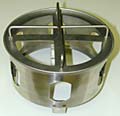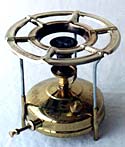
![]()
Search the Journey to Forever website – click HERE
Journey to Forever:
Make a donation
En español
Biocombustibles, biodiesel
Navigation
Contact usTo Keith Addison Handmade Projects |
Heaters, burners and stoves
 Free heating!
Free heating!
Roger Sanders has updated his popular improved version of the Mother Earth News waste oil heater with a great deal of new information and new options.
This waste oil heater solves all the problems that made the original MEN version difficult to use.
Roger's design is simple and reliable -- it's easy to build and easy to use, it's quiet, it uses no electricity, it's easy to light, easy to clean and easy to control, it has a wide heat range, and it runs on waste vegetable oil (WVO) just as well as on used engine oil. It can save you thousands of dollars in heating bills.
The Second Edition is available as a pdf e-book, price $22.50. Complete DIY instructions -- buy it HERE.
Spanish
Spanish-language version HERE.
Waste oil heaters
 Free heating!
Free heating!Roger Sanders has updated his popular improved version of the Mother Earth News waste oil heater with a great deal of new information and new options.
This waste oil heater solves all the problems that made the original MEN version difficult to use.
Roger's design is simple and reliable -- it's easy to build and easy to use, it's quiet, it uses no electricity, it's easy to light, easy to clean and easy to control, it has a wide heat range, and it runs on waste vegetable oil (WVO) just as well as on used engine oil. It can save you thousands of dollars in heating bills.
The Second Edition is available as a pdf e-book, price $22.50. Complete DIY instructions -- buy it HERE.
Spanish
Spanish-language version HERE.
Roger Sanders' Waste Oil Heater
Mother Earth News Waste Oil Heater -- original version
Journey to Forever's MEN Waste Oil Heater
Modifications:
Bruce Woodford's forced-air waste oil heater
Journey to Forever's forced-air biofuel heater
-- Bioheating oil
Turk burner
Home heating
Oil-fired furnaces
Lamps and stoves
Wood fires that fit
Improved cookstoves
- Rice-husk stoves -- The Manufacture of a Cement Extender from Rice-Husks using a Basket-Burner
Wood-gas stoves
- Cookstoves for schools -- A wood-gas stove made from three tin cans.
Charcoal
Resources
Ethanol stove -- "Development of Stove running on low ethanol concentration", Anil K. Rajvanshi , S. M. Patil and Y. H. Shaikh, Nimbkar Agricultural Research Institute (NARI) -- 80k Acrobat file.
Bioheating oil
We use bioheating oil with Journey to Forever's forced-air biofuel heater
To make 60 litres of bioheating oil:
Use the single-stage base transesterification method for making biodiesel.
Use 3 litres of methanol. Mix it with the usual 3.5 grams of NaOH or KOH equivalent per litre of oil plus the amount indicated by titration. See Mixing the methoxide.
Process in the usual way using 20 to 30 litres of vegetable oil, agitate for one hour with temperature maintained at about 55 deg C.
This is enough methanol (10-15%) to produce a "split": the glycerin molecule is displaced and replaced by methanol molecules, forming methyl esters.
After one hour processing add another 30 or 40 litres of WVO to bring the total to 60 litres.
Process for another hour, maintaining heat at 55 deg C.
Settle overnight, separate the by-product, use the bioheating oil in your heater or burner.
More methyl ester is formed in the second hour after adding the extra WVO, but there will also be much higher amounts of unconverted and partly converted glycerides left than any biodiesel standards will allow -- this fuel is for your heater, NOT for your car!
Using the standard amount of lye for 60 litres means that all or most of the Free Fatty Acids are converted to soap and removed with the by-product along with the glycerine.
In fact the Free Fatty Acids make quite a good heating fuel when separated from the by-product "cocktail", but not as good as bioheating oil.
There's no need to take the trouble to wash bioheating oil. Anyway it's probably difficult to wash -- not much soap but lots of half-baked glycerides which act as emulsifiers.
There's little or no free methanol left so it should be safe if you want to use it in the type of burner or furnace that has rubber pipes and seals, but we haven't tried that and it might be wise to change the rubber parts for resistant material anyway.
Some burners are more sensitive to viscosity than others. Biodiesel is more viscous than petroleum heating oil, and bioheating oil is more viscous than biodiesel, so if biodiesel doesn't work in your furnace then bioheating oil won't either, though in both cases pre-heating the oil might work.
This method of making bioheating oil works well, but it's probably a moveable feast -- try adapting it, experiment a bit. All you have to do is get it to split and drop the glycerine. If you can do that at lower temperatures or with shorter processing times the oil will be even cheaper, and please tell us how you did it!
If it doesn't split it might be less viscous because of the methanol, but what you'll have is a mixture of WVO, methanol and soap. It might burn quite well because of the methanol, but it probably won't burn the soap properly, it might smoke quite badly and there'll be a build-up of gunky residue in the burner. Reprocess it so you get a split.
Home heating
See:
Waste Oil Heaters
Oil-fired furnaces:
Frequently Asked Question: "Can I burn bio-diesel in my furnace? I now burn standard fossil fuel oil."
Answer: Yes you can, but it depends on the furnace. Some need some adaptation, others don't. Whichever, it must be washed biodiesel -- the methanol in unwashed biodiesel will rot the rubber parts.
Biodiesel replacing Home Heating Oil -- from Tom Kelly, Biofuel mailing list, 7 Apr 2008
- Increased pump pressure from 100 psi to 125 psi
- Changed nozzle from 1.0 gph/80 degree to .75gph/80 degree
- Reduced air flow into the burner
- Sealed any openings to chamber other than the inspection port.
- Switched from a Suntech to a Webster Bio-Pump ("biodiesel compatible")
It now runs reliably on B100 (100% biodiesel). I haven't bought HHO in two years.
- My storage tank is in my basement, with about 50 deg F (10 deg C) winter temperatures.
- I ran the fuel line up and then down a section of pipe that carries hot water to my baseboard heaters. It is heavily insulated. During the coldest times of the year the fuel is warmed a bit before it gets to the pump. This is not the same as a nozzle pre-heater. I have one, but never installed it.
- For my heating system I make a lower quality biodiesel (16-18 % methanol vol/vol, and brewed in larger batches) that does not quite pass the quality test. It is washed and dried. I suggest that as you "tune" your heating system, you use quality biodiesel in order to rule out the fuel quality variable.
- The "day tank" will be useful later if you want to experiment with burning lower-quality biodiesel, biodiesel/WVO blends, biodiesel/FFA blends. At this point a nozzle pre-heater may come in handy.
This is not a one-size-fits-all situation. Different systems seem to involve different adjustments; no serious modifications however.
-- Tom Kelly
I've been burning biodiesel in my home heating system for three heating seasons. I have a Beckett burner on my Burnham boiler. It supplies heat and domestic hot water.
I suggest that you "T" a small tank into the fuel line so that you can make adjustments to the system using increasing blends of biodiesel. Be sure to use flare fittings and solid brass valves. Compression fittings and cheap valves tend to leak. Have spare filter cartridges and nozzles on hand.
Year One: I used approx. 20% blend in my storage tank without any modifications. Experimented with higher biodiesel blends in my small "day tank" and ran into start-up problems as the blend approached 40% biodiesel.
Modifications:
Alternative fuels furnace forum -- altfuelfurnace
Alternative fuels, like SVO (straight vegetable oil, waste vegetable oil), waste motor oil and biodiesel are being successfully burned in adapted residential oil-fired furnace burners such as Arco, R.W. Beckett, Carlin, Ducane, Esso, International, Riello, Slant Finn and Wayne. The forum is a meeting place to exchange information and ideas in adapting residential oil burners that use HHO (home heating oil) to these alternative fuels.
http://groups.yahoo.com/group/altfuelfurnace/
Subscribe: altfuelfurnace-subscribe@yahoogroups.com
Riello Burners and Bio-fuel -- Synthesis of the experiences with the bio-fuel -- Report on using biodiesel from the Burner Division at Riello's Combustion Research Centre in Italy (with thanks to Damian Dolan)
28kb Acrobat file.
Biodiesel Heating, by Carol E. Moné, Homepower Magazine, Issue 97, October/November, 2003, p40-44 -- Switching a 30-year-old oil-fired furnace to biodiesel for domestic space heating. From Homepower Magazine (purchase issue online):
http://www.homepower.com/
Biodiesel Blends in Space Heating Equipment, by C.R. Krishna, Brookhaven National Laboratory, sponsored by the US Department of Energy, National Renewable Energy Laboratory (NREL), December 2001 -- An evaluation of the performance of blends of biodiesel and home heating oil in space heating applications. 32-page Acrobat file, 676kb
http://www.nrel.gov/docs/fy04osti/33579.pdf
Low Cost Bioheating Oil Application, by C.R. Krishna, Brookhaven National Laboratory, 2003 (US DOE Contract). Describes combustion tests with soy biodiesel blends in a residential boiler and a commercial boiler. 24 pages, Acrobat file 1.3Mb
http://www.pubs.bnl.gov/documents/25436.pdf
Combustion Testing of a Bio-diesel Fuel Oil Blend in Residential Oil Burning Equipment, John E. Batey, PE, Energy Research Center, Inc., 2003, for Massachusetts Oilheat Council & National Oilheat Research Alliance -- 59 pages, Acrobat file 176kb
http://www.biodiesel.org/resources/reportsdatabase/
reports/hom/20030801_htg-002.pdf
Biodiesel Home Heating Experiences, by Myles Twete -- Burning 100% biodiesel fuel made from used vegetable oil in a residential oil-fired furnace.
http://home.comcast.net/~matwete/biodiesel/
BiodieselHomeHeatingExperiences.htm
Lamps and stoves
Biodiesel does not travel up a wick very well, like kerosene or heating oil will, so it can't be used for ordinary wick lamps or stoves. However, tests have found that it will travel about 7cm up a wick but not more than that, and the wick should preferably be thick (about 1cm) and loosely wound -- tightly-woven commercial wicks won't work well. Biodiesel also might not work in heating furnaces or stoves, though some models work just fine, and others can be adjusted.
 BriteLyt Petromax multi-fuel lanterns work just fine with biodiesel. "We are happy to report that the burn-time was over 8 hours, at the highest setting, and you did not have to re-pressurize the lantern as often as you would using other fuel-types. The performance was great, and the lantern was just as bright, and there was NO SMELL. Using the product inside, we noticed no smell at all." The lanterns also work with ethanol. 150CP lanterns, run up to 20 hours,1 pint of fuel, approx 100-watts; 500CP lanterns, approx 400-watts. There's a stove-top accessory so you can cook with them too.
BriteLyt Petromax multi-fuel lanterns work just fine with biodiesel. "We are happy to report that the burn-time was over 8 hours, at the highest setting, and you did not have to re-pressurize the lantern as often as you would using other fuel-types. The performance was great, and the lantern was just as bright, and there was NO SMELL. Using the product inside, we noticed no smell at all." The lanterns also work with ethanol. 150CP lanterns, run up to 20 hours,1 pint of fuel, approx 100-watts; 500CP lanterns, approx 400-watts. There's a stove-top accessory so you can cook with them too.
http://www.britelyt.com/
Message from tvoivozhd to the Homestead mailing list:
Several years back we had a discussion on homestead lanterns. I mentioned one that the Cuban exodus brought with them because they could fit their nesting three-pots on top to cook an entire meal simultaneously with very little fuel, and also have light for night-time field or house activities.
I had one of those, brand-name Aida which got damaged in a daughter's camping trip and never could replace it, even though I enlisted the help of the German Embassy to find the source.
The soul-brothers were first the Petromax, and now the Brite-Lyt. This has to be the best, brightest, most economical, most useful emergency light in the world. I'm going to get one, including the cooktop unit. These lantern-cooktops burn kerosene, quieter, cheaper than a Coleman, with about twice the candlepower.

Cooktop unit
Since they burn kerosene they are a lot safer than the white gas Coleman fuel, and you don't have to worry about the light ends evaporating out and clogging up the fuel jet. They are expensive, but in my experience well worth every penny of the approximate $150 price, including the $50 cooktop. Mine had the best, easiest to use, most durable ignitor built-in that I have ever seen---I have one of those sleazy, hard to attach, hard to operate, ineffective Coleman ignitors---you really have to buy a separate piezoelectric for the Colemans, and of course since it is not attached, you will not be able to find it or insert it when the power goes out.
 Stoves
Stoves
We've been using biodiesel in this kerosene pressure stove for nearly two years. See one burning biodiesel here. These stoves are common in 3rd World countries ("roarers"), but they're rare in industrialised countries. Ours came from India and it cost US$8. Here are some stoves you can buy on the Internet, but not for $8.
BriteLyt Multi-Fuel Brass Pressure Stove. Same family as the BriteLyt-Petromax multifuel pressure lantern, which can burn biodiesel or ethanol (see above, lamps).  The stove has an adjustable burner, with preheater and lantern parts and a pressure indicator. Preheats in same manner as the BriteLyt-Petromax lantern. Empty weight 4lbs, fuel capacity approx. 1 qt., 8K-10K BTUs, runs 5-6 hours, on oil base fuels. Polished Brass, Matte Finish on Brass, or Nickel Plated Brass, price: $75.00.
The stove has an adjustable burner, with preheater and lantern parts and a pressure indicator. Preheats in same manner as the BriteLyt-Petromax lantern. Empty weight 4lbs, fuel capacity approx. 1 qt., 8K-10K BTUs, runs 5-6 hours, on oil base fuels. Polished Brass, Matte Finish on Brass, or Nickel Plated Brass, price: $75.00.
http://britelyt.groupee.net/stoves.htm
 Brass Pressure Stove -- 8.5 inches wide and 7.5 inches tall, disassembles quickly, produces around 8,000 btu, runs on kerosene or diesel fuel. Available in the US via the Internet, priice $48. No wicks, it holds a little more than a pint of fuel and will run 3-4 hours on one tankful.
Brass Pressure Stove -- 8.5 inches wide and 7.5 inches tall, disassembles quickly, produces around 8,000 btu, runs on kerosene or diesel fuel. Available in the US via the Internet, priice $48. No wicks, it holds a little more than a pint of fuel and will run 3-4 hours on one tankful.
http://www.stpaulmercantile.com/buttrfly.htm
Survival Supply Canada Inc., Kerosene Brass Pressure Stove, compact, about 9,000 btu, $89.00
http://www.survivalpro.com/catalog/product_info.php?products_id=45
Try these companies in India:
Lovsons Exports -- Kerosene pressure stoves, lanterns, blowlamps, parts
http://www.lovson.com/household-plastics.html
Ruchi Brand Kerosene Brass Pressure Stove
http://www.roleximpex.com/kerosene-stoves-petromax.html
Kerosene Pressure Stoves
http://www.surgicalshop.com/hospital_medical_supplies/
kerosene_stoves_lamps.html
Kerosene pressure stoves, single burner 1 Litre., 1.5 Litres, 3 Litres, Double burner 2 Litres, Four burner 2 Litres.
http://narang.com/miscellaneous_surgical_medical_products/
kerosene-stove.php
XGK™ Expedition Stove: "This stove is tough enough to handle any fuel—white gas, kerosene and even poor quality diesel, to name a few."
http://www.msrcorp.com/prod/prod_stoves1.htm
WhisperLite Internationale™ 600: Multi-fuel burning lightweight camping stoves -- use MSR White Gas, kerosene, jet fuel or auto gas.
http://www.msrcorp.com/prod/prod_stoves1.htm#4
Optimus NOVA Multifuel Expedition Stove -- The burner capacity is enough to prepare meals for two persons in extreme conditions. Multifuel technology means that you will find fuel anywhere in the world. Appr. 2.850 Watts/9,700 BTU. Burning time: Up to 2.5 hours at high output (one filling=0.45 L /15.5 fl.oz.).
http://www.optimus.se/products/nova/
Optimus HIKER Multifuel Expedition Stove -- "The Himalaya Stove". The Hiker is a multifuel stove, wherever you go, you will be able to find fuel for your Hiker. No conversion needed between ordinary fuels (when using methylated spirits/alcohol, simply change the burner jet). Fuels: Kerosene/paraffin, white gasoline/petrol, diesel oil, methylated alcohol/spirits and Coleman fuel. Appr. 3.000 watts/10.000 BTU. Burning time: Up to 2 hours on one filling (0.35 litres/12 oz.) at high output.
http://www.optimus.se/products/hiker/
Ethanol stove -- "Development of Stove running on low ethanol concentration", Anil K. Rajvanshi , S. M. Patil and Y. H. Shaikh, Nimbkar Agricultural Research Institute (NARI) -- 80k Acrobat file.
Purifying vegetable oils for use in lamps: Fixed oils: To Purify Rape Oil.
Biofuels at Journey to Forever
Biofuel
En español -- Biocombustibles, biodiesel
Biofuels Library
Biofuels supplies and suppliers
Biodiesel
Make your own biodiesel
Mike Pelly's recipe
Two-stage biodiesel process
FOOLPROOF biodiesel process
Biodiesel processors
Biodiesel in Hong Kong
Nitrogen Oxide emissions
Glycerine
Biodiesel resources on the Web
Do diesels have a future?
Vegetable oil yields and characteristics
Washing
Biodiesel and your vehicle
Food or fuel?
Straight vegetable oil as diesel fuel
Ethanol
Ethanol resources on the Web
Is ethanol energy-efficient?